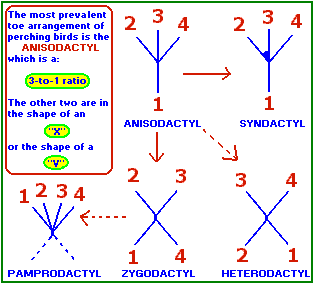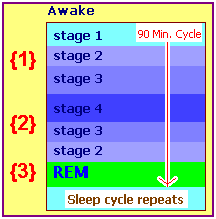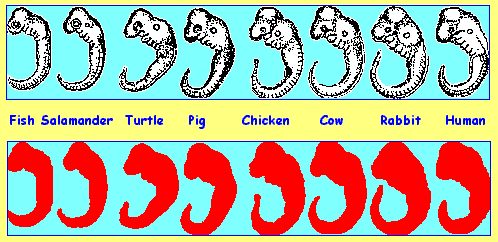Page K
(Study of Threes)
http://threesology.org
Researchers as of 11/20/2019
| 3-to-1 A | 3-to-1 B | 3-to-1 C | 3-to-1 D | 3-to-1 E | 3-to-1 F |
| 3-to-1 G | 3-to-1 H | 3-to-1 I | 3-to-1 J | 3-to-1 K | 3-to-1 L |
| 3-to-1 M | 3-to-1 N | 3-to-1 O | 3-to-1 P | 3-to-1 Q | 3-to-1 FF |
When we look at the toe arrangements of perching birds, we find that the most prevalent stance is the (anisodactyl) 3-to-1 ratio (of three toes in front and the (first digit) hallux pointing rearward) with the other two stances being an "X" and a "V" (and some may want to include the view that a "Y" is present):

The solid arrows indicate the (presumed) evolution of this stance and the Dashed arrows indicate uncertain derivations. The syndactyl foot, (of the Coraciiformes) has the bases of toes 2 and 3 fused. The zygodactyl arrangement, with two forward and two rearward-pointing toes (which forms an "X,") has been achieved in different ways nine times during bird evolution. In trogons, toe 2, and not toe 4, is rear-directed (heterodactyl). In the pamprodactyl foot, the positions of toes 1 and 4 are not fixed; all four toes may point to the front (creating a "V" pattern).
Information and illustration adapted from page 53, of the Book "Ornithology" by Frank B. Gill, 1995.
Let us also include another 3 to 1 ratio example from the field of automotive servicing with respect to tire rotation. What we find is the usage of 3 crisscross patterns to 1 non-crisscross pattern, though there are individualized variations of tire rotation depending on whether an owner themselves is doing the work or a tire facility that is hired by the vehicle's owner. (In other words, the owner may be lazy and only change one tire with the spare and not rotate the entire set.):

Notice also that there are 3 variations of crisscross pattern and 3 variations of the front/back pattern.
Advertisements in America frequently indicate that if you buy three tires you can get 1 free. (Meaning too much is being charged for each tire in the first place... and the tire rotation pattern(s) are meant to wear out all the tires at the same time so you have to replace all of them instead of just one or two if they were left in the same spot.)
*** Since the fertile life of the human egg cell lasts at most one day and that of the human sperm at most two days, there is a period of about three days during which copulation can result in conception (the day when the egg is fertile and the two preceding days).
*** Generally speaking, the egg traverses the fallopian tube in about 3 days; Sperm can travel at a rate of 3 inches per hour;
A spermagonium gives rise to 3 active cells and 1 resting cell.
When we look at RNA and DNA using the above "active and resting" criteria, we can see 3 "active" amino acids in the sense that they are mobile by occurring with both RNA & DNA, and 1 "resting" amino acid in the sense that they remain solely with RNA or DNA:
3 "active" {Adenine~ Cytosine~ Guanine} to 1 "resting" {Uracil} = RNA
3 "active" {Adenine~ Cytosine~ Guanine} to 1 "resting" {Thymine} = DNA
But even if you would prefer to say the obverse that there are 3 "resting" amino acids and 1 "active" amino acid, there would none-the-less be a 3-to-1 ratio.
3-part sleep pattern that is said to have been found in every warm-blooded creature on earth: Deep sleep ~ Light sleep ~ REM (Rapid Eye Movement associated with dreaming.)
3, 4, or 5 Cycles per night (though I have also read 4, 5, or 6 cycles), all of which last approximately 90 minutes in length (before repeating), is the frequency in which the stages of sleep are said to occur.(90 minutes is the typical length of a motion picture).
If we include the waking/consciousness state as a stage, we have six stages. With a five-stage reference, we have:
- Stages 1, 2, 3 as a group.
- Stages 4, 3, 2 as a group.
- REM (Rapid Eye Movement as lull point which signals the repeat of the stages sequence.
(After REM, the sequence repeats: 1- 2- 3- 4- 3- 2- REM 1- 2- 3- 4- 3- 2-...etc...
This simple counting sequence reminds me of the history of number usage by primitive peoples (and also the firing order of an internal combustion engine). If we add the waking/consciousness state, we have a 3 to 1 ratio configuration. It also brings me to the consideration of whether human society repeats a similar sequence, which would explain the repetition of war, of idiot politicians, inadequate social measures to effectively address the recurrences of poverty, criminal behavior, medical maladies, etc...)

I am using colors to denote the different stages of sleep, with the darkest color representing "Deep" sleep as an analogy to the darkest color representing the deep part of an ocean as might be seen in an illustration that shows the different water depths by using differing colors...the lighter colors indicating shallower depths and the darker colors progressively showing deeper depths. What comes to mind when I view this is that the colors are representing some sort of colorized musical score. I also visualize this portrayal of sleep stages as a metaphorical representation of developmental biology in the early ocean so many billions of years ago. Life may very well had a fluctuating series of developmental stages at different depths of the ocean.
It is interesting to wonder whether our sleep cycle is a nightly recreation of our primordial development, just as our embryonic state is said to re-experience the development that the biological process of so many animals have passed through and yet come to diverge from the human blueprint in later developmental stages.(It is typically called "Ontogeny recapitulates Phylogeny," but has been re-phrased to reflect our present day understanding of early developmental processes:
For those who are unfamiliar with the concept, it is a theory formulated by Earnest M. Haeckel which states that individuals in their embryonic development pass through stages similar in general structural plan to the stages their species passed through in its evolution. In other words, the (embryonic) development of an individual (Ontogeny) is an abbreviated time-accelerated motion picture which shows the (embryonic) development of an individual species such as all vertebrates.
Below is a small representation of the embryonic stage of development of several species which do indeed exhibit a similarity:

But not only does the sleep stage sequence remind me of the history of number usage of primitive peoples, it also reminds me of (overall 90 minute) sequences found in other areas. Here are a handful of correlations:
|
3 to 1 ratio:
These can be called the cyclical "moments" of the four stroke engine. A four cylinder engine based
on a 360 degree rotation is divided into four 90 degree sections, while a six cylinder is 60 degrees and an eight cylinder is 45
degrees. The American standard firing order for a four cylinder water-cooled engine is 1-3-4-2, while the air-cooled Volkswagen, for
instance, uses a 1-4-3-2. With respect to current engine design, it is said that a 1-2-3-4 firing order would shake, rattle, and roll
the engine and possibly tear it from its mounts. Current engine design is in its infancy based on the analogy that it uses a liquid,
instead of a solid food diet.) Take a look at how the primivity of the 1- 2- 3- 4 numerical concept development can be applied to represent a philosophical perspective... (Notice that a reverse usage of it obscures its simplistic numerological origin.): The Hindu Yuga cycle is most definitely based upon the tetractys with a root number of 432 which is the tetractys ratio in reverse order, with the number 1 or unity dropped, viz: 1-2-3-4 reversed to 4-3-2-(1 dropped). Thus, the numbers of years in a Kali Yuga is 432,000 years and each successive Yuga adds to the ten-foldness of the Maha Yuga of 4,320,000 years. This sacred number 432 of the tetractys saturates ancient Hindu, Babylonian, Chaldean and Egyptian cosmological systems. For example, according to Berossus, the reign of the ten antediluvian kings in the Babylonian Marduck mythology was 432,000 years and this was called their "great year". In the Hindu RG VEDA, (the oldest written text) the 10,800 stanzas average forty syllables per stanza for a total of 432,000. In the geometry of Ptolemy, the diameter of his great circles is 432,000 and in his musical theory 432,000 is the least common denominator of his monochord fractions. |
|
3 to 1 ratio:
(Called the four seasons, with each season occurring approximately 90 days apart.) |
|
3 to 1 ratio:
(Called the 4, or 5, or 6 stages of sleep that occur every 90 minutes.) |
|
3 to 1 ratio:
(Called the four bases of the triplet genetics code. Is there an as yet unidentified 90-type of reference to the code?) |
|
3 to 1 ratio:
(Called the four intervals in music. [90...?]) |
|
3 to 1 ratio:
(Called the four blood types in the ABO blood typing scheme. [90...?]) |
|
3 to 1 ratio:
(Called the four parts/functions, hierarchal stages of the brain. [90...?] |
|
3 to 1 ratio:
(Called the four types of teeth. [90...?] |
|
3 to 1 ratio:
(Called the four parts of a News program that may occur in One 30- minute segment, Two 30- minute segments, or Many 30 minute segments during a national disaster.) |
Take a look at the following and compare the steps in this cycle with the cyclical pattern of sleep:
Determination of Mating Type by PCR (Polymerase Chain Reaction):
| Sleep cycle: | PCR cycle: | ||
| stage 1 | step 1 | 94°C | 4 min |
| stage 2 | step 2 | 94°C | 30 sec |
| stage 3 | step 3 | 52°C | 30 sec |
| stage 4 | step 4 | 72°C | 2 min |
| stages 4- 3- 2 | repeat step 2 to step 4 for 30 cycles | ||
| REM stage | step 5 | 72°C | 5 min |
Page Created: Monday, June 24, 2013, 4:56 AM
Latest Posting: Monday, 11th August 2025... 10:11 AM